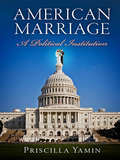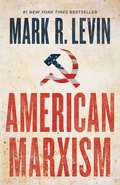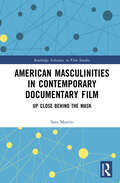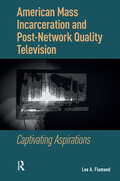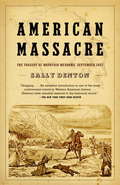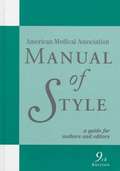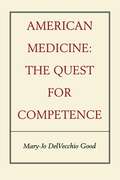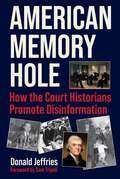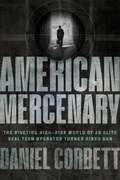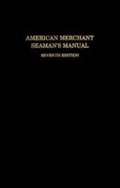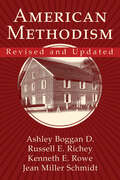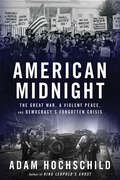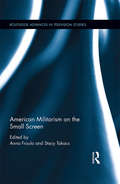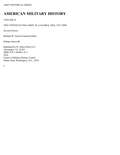- Table View
- List View
American Marriage
by Priscilla YaminAs states across the country battle internally over same-sex marriage in the courts, in legislatures, and at the ballot box, activists and scholars grapple with its implications for the status of gays and lesbians and for the institution of marriage itself. Yet, the struggle over same-sex marriage is only the most recent political and public debate over marriage in the United States. What is at stake for those who want to restrict marriage and for those who seek to extend it? Why has the issue become such a national debate? These questions can be answered only by viewing marriage as a political institution as well as a religious and cultural one.In its political dimension, marriage circumscribes both the meaning and the concrete terms of citizenship. Marriage represents communal duty, moral education, and social and civic status. Yet, at the same time, it represents individual choice, contract, liberty, and independence from the state. According to Priscilla Yamin, these opposing but interrelated sets of characteristics generate a tension between a politics of obligations on the one hand and a politics of rights on the other. To analyze this interplay, American Marriage examines the status of ex-slaves at the close of the Civil War, immigrants at the turn of the twentieth century, civil rights and women's rights in the 1960s, and welfare recipients and gays and lesbians in the contemporary period. Yamin argues that at moments when extant political and social hierarchies become unstable, political actors turn to marriage either to stave off or to promote political and social changes. Some marriages are pushed as obligatory and necessary for the good of society, while others are contested or presented as dangerous and harmful. Thus political struggles over race, gender, economic inequality, and sexuality have been articulated at key moments through the language of marital obligations and rights. Seen this way, marriage is not outside the political realm but interlocked with it in mutual evolution.
American Marxism
by Mark R. Levin#1 NEW YORK TIMES BESTSELLER The seven-time #1 New York Times bestselling author, Fox News star, and radio host Mark R. Levin explains how the dangers he warned against in the &“timely yet timeless&” (David Limbaugh, author of Jesus Is Risen) bestseller Liberty and Tyranny have come to pass. In 2009, Mark R. Levin galvanized conservatives with his unforgettable manifesto Liberty and Tyranny, by providing a philosophical, historical, and practical framework for halting the liberal assault on Constitution-based values. That book was about standing at the precipice of progressivism&’s threat to our freedom and now, over a decade later, we&’re fully over that precipice and paying the price. In American Marxism, Levin explains how the core elements of Marxist ideology are now pervasive in American society and culture—from our schools, the press, and corporations, to Hollywood, the Democratic Party, and the Biden presidency—and how it is often cloaked in deceptive labels like &“progressivism,&” &“democratic socialism,&” &“social activism,&” and more. With his characteristic trenchant analysis, Levin digs into the psychology and tactics of these movements, the widespread brainwashing of students, the anti-American purposes of Critical Race Theory and the Green New Deal, and the escalation of repression and censorship to silence opposing voices and enforce conformity. Levin exposes many of the institutions, intellectuals, scholars, and activists who are leading this revolution, and provides us with some answers and ideas on how to confront them. As Levin writes: &“The counter-revolution to the American Revolution is in full force. And it can no longer be dismissed or ignored for it is devouring our society and culture, swirling around our everyday lives, and ubiquitous in our politics, schools, media, and entertainment.&” And, like before, Levin seeks to rally the American people to defend their liberty.
American Masculinities in Contemporary Documentary Film: Up Close Behind the Mask (Routledge Advances in Film Studies)
by Sara MartínMost documentaries deal with men, but what do they actually say about masculinity? In this groundbreaking volume Sara Martín analyses more than forty 21st-century documentaries to explore how they represent American men and masculinity. From Jennifer Siebel Newsom’s The Mask You Live In to Raoul Peck’s I Am Not Your Negro, this volume explores sixteen different faces of American masculinity: the good man, the activist, the politician, the whistleblower, the criminal, the sexual abuser, the wrongly accused, the dependent man, the soldier, the capitalist, the adventurer, the sportsman, the architect, the photographer, the musician, and the writer. The collective portrait drawn by the documentaries discloses a firm critical stance against the contradictions inherent in patriarchy, which makes American men promises of empowerment it cannot fulfill. The filmmakers’ view of American masculinity emphasizes the vulnerability of disempowered men before the abuses of the patriarchal system run by hegemonic men and a loss of bearings about how to be a man after the impact of feminism, accompanied nonetheless by a celebration of resilient masculinity and of the good American man. Firmly positioning documentaries as an immensely flexible, relevant tool to understand 21st-century American men and masculinity, their past, present, and future, this book will interest students and scholars of film studies, documentary film, American cultural studies, gender, and masculinity.
American Mass Incarceration and Post-Network Quality Television: Captivating Aspirations
by Lee FlamandFar more than a building of brick and mortar, the prison relies upon gruesome stories circulated as commercial media to legitimize its institutional reproduction. Perhaps no medium has done more in recent years to both produce and intervene in such stories than television. This unapologetically interdisciplinary work presents a series of investigations into some of the most influential and innovative treatments of American mass incarceration to hit our screens in recent decades. Looking beyond celebratory accolades, Lee A. Flamand argues that we cannot understand the eagerness of influential programs such as OZ, The Wire, Orange Is the New Black, 13th, and Queen Sugar to integrate the sensibilities of prison ethnography, urban sociology, identity politics activism, and even Black feminist theory into their narrative structures without understanding how such critical postures relate to the cultural aspirations and commercial goals of a quickly evolving TV industry and the most deeply ingrained continuities of American storytelling practices.
American Massacre: The Tragedy At Mountain Meadows, September 1857
by Sally DentonControversy has raged over identity of the organizers and participants of the "Mountain Meadows Massacre" ever since a California-bound wagon train was beset in Utah Territory in 1857 by local Mormons and Paiute Indians (as the story is conventionally told--Paiutes contest this version and are now supported by physical evidence), killing all but seven of the 140 emigrants over the course of four days. The only person ever held criminally responsible for the crime, John D. Lee, was executed 20 years later, condemning the Mormon Church Leaders as the real instigators of the crime. Investigative reporter Denton revisits those events, exploring the development and aftermath of the episode, concluding that Brigham Young and other church leaders were indeed responsible. Annotation (c)2003 Book News, Inc., Portland, OR (booknews.com)
American Media and the Memory of World War II (Routledge Research in Cultural and Media Studies)
by Debra RamsayFor three generations of Americans, World War II has been a touchstone for the understanding of conflict and of America’s role in global affairs. But if World War II helped shape the perception of war for Americans, American media in turn shape the understanding and memory of World War II. Concentrating on key popular films, television series, and digital games from the last two decades, this book explores the critical influence World War II continues to exert on a generation of Americans born over thirty years after the conflict ended. It explains how the war was configured in the media of the wartime generation and how it came to be repurposed by their progeny, the Baby Boomers. In doing so, it identifies the framework underpinning the mediation of World War II memory in the current generation’s media and develops a model that provides insight into the strategies of representation that shape the American perspective of war in general.
American Medical Association Boy's Guide to Becoming a Teen: Getting Used to Life in Your Changing Body
by American Medical AssociationA boy&’s &“straightforward, accessible, and nonjudgmental&” guide to everything they need to know about puberty and becoming a teen (Booklist). Becoming a teen is an important milestone in every boy&’s life. It&’s especially important at this time to get answers and advice from a trusted source. The American Medical Association Boy&’s Guide to Becoming a Teen is filled with invaluable advice to get you ready for the changes you will experience during puberty. Learn about these important topics and more: · Puberty and what kinds of physical and emotional changes you can expect—from your developing body to your feelings about girls · The importance of eating the right foods and taking care of your body · Pimples, acne, and how to properly care for your skin · Your reproductive system—inside and out · Thinking about relationships and dealing with new feelings The American Medical Association Boy&’s Guide to Becoming a Teen will help you understand the health issues that are of most concern to teenage boys, and will teach you how to be safe, happy, and healthy through these years.
American Medical Association Girl's Guide to Becoming a Teen: Getting Used to Life in Your Changing Body
by American Medical AssociationA girl&’s straightforward, accessible, and nonjudgmental guide to everything they need to know about adolescence and growing up. Becoming a teen is an important milestone in every girl&’s life. It&’s especially important at this time to get answers and advice from a trusted source. The American Medical Association Girl&’s Guide to Becoming a Teen is filled with invaluable advice to get you ready for the changes you will experience during puberty. Learn about these important topics and more: · Puberty and what kinds of physical and emotional changes you can expect—from your developing body to your feelings about boys · The importance of eating the right foods and taking care of your body · Your reproductive system inside and out · Starting your period—what it means and how to handle it · Thinking about relationships and dealing with new feelings The American Medical Association Girl&’s Guide to Becoming a Teen will help you understand the health issues that are of most concern to teenage girls, and will teach you how to be safe, happy, and healthy through these years. &“Girls covers the physical and emotional changes that puberty brings, along with solid tips about grooming, diet, exercise, and other health issues, such as eating disorders. . . . Girls will find plenty of useful information.&” —Booklist
American Medical Association Manual of Style: A Guide for Authors and Editors (9th edition)
by Cheryl IversonThe latest edition features an expanded chapter on legal and ethical concerns in publishing. Readers will also find an extensive chapter on statistics, a completely updated chapter on nomenclature, new policies for eponyms and numbers styles, a larger references section, an expanded discussion of inclusive language and abbreviations, and a larger section on figures and tables. A new section on typography is also featured, along with current information on electronic publishing, encompassing rapid changes affecting the publishing environment. End-of-chapter references make the book easier to use, and the entire text is reviewed by more than 70 editors for accuracy and dependability.
American Medicine As Culture
by Howard F. SteinThis book situates biomedicine within American culture and argues that the very organization and practice of medicine are themselves cultural. It demonstrates the symbolic construction of clinical reality within American biomedicine and shows how biomedicine never leaves the realm of the personal.
American Medicine: The Quest for Competence
by Mary-Jo DelVecchio GoodWhat does it mean to be a good doctor in America today? How do such challenges as new biotechnologies, the threat of malpractice suits, and proposed health-care reform affect physicians' ability to provide quality care?These and many other crucial questions are examined in this book, the first to fully explore the meaning and politics of competence in modern American medicine. Based on Mary-Jo DelVecchio Good's recent ethnographic studies of three distinct medical communities—physicians in rural California, academics and students involved in Harvard Medical School's innovative "New Pathway" curriculum, and oncologists working on breast cancer treatment—the book demonstrates the centrality of the issue of competence throughout the medical world. Competence, it shows, provides the framework for discussing the power struggles between rural general practitioners and specialists, organizational changes in medical education, and the clinical narratives of high-technology oncologists. In their own words, practitioners, students, and academics describe what competence means to them and reveal their frustration with medical-legal institutions, malpractice, and the limitations of peer review and medical training.Timely and provocative, this study is essential reading for medical professionals, academics, anthropologists, and sociologists, as well as health-care policymakers.
American Memories: Atrocities and the Law
by Ryan D. King Joachim J. SavelsbergIn the long history of warfare and cultural and ethnic violence, the twentieth century was exceptional for producing institutions charged with seeking accountability or redress for violent offenses and human rights abuses across the globe, often forcing nations to confront the consequences of past atrocities. The Holocaust ended with trials at Nuremberg, apartheid in South Africa concluded with the Truth and Reconciliation Commission, and the Gacaca courts continue to strive for closure in the wake of the Rwandan genocide. Despite this global trend toward accountability, American collective memory appears distinct in that it tends to glorify the nation’s past, celebrating triumphs while eliding darker episodes in its history. In American Memories, sociologists Joachim Savelsberg and Ryan King rigorously examine how the United States remembers its own and others’ atrocities and how institutional responses to such crimes, including trials and tribunals, may help shape memories and perhaps impede future violence. American Memories uses historical and media accounts, court records, and survey research to examine a number of atrocities from the nation’s past, including the massacres of civilians by U.S. military in My Lai, Vietnam, and Haditha, Iraq. The book shows that when states initiate responses to such violence—via criminal trials, tribunals, or reconciliation hearings—they lay important groundwork for how such atrocities are viewed in the future. Trials can serve to delegitimize violence—even by a nation’s military— by creating a public record of grave offenses. But the law is filtered by and must also compete with other institutions, such as the media and historical texts, in shaping American memory. Savelsberg and King show, for example, how the My Lai slayings of women, children, and elderly men by U.S. soldiers have been largely eliminated from or misrepresented in American textbooks, and the army’s reputation survived the episode untarnished. The American media nevertheless evoked the killings at My Lai in response to the murder of twenty-four civilian Iraqis in Haditha, during the war in Iraq. Since only one conviction was obtained for the My Lai massacre, and convictions for the killings in Haditha seem increasingly unlikely, Savelsberg and King argue that Haditha in the near past is now bound inextricably to My Lai in the distant past. With virtually no criminal convictions, and none of higher ranks for either massacre, both events will continue to be misrepresented in American memory. In contrast, the book examines American representations of atrocities committed by foreign powers during the Balkan wars, which entailed the prosecution of ranking military and political leaders. The authors analyze news accounts of the war’s events and show how articles based on diplomatic sources initially cast Serbian President Slobodan Milosevic in a less negative light, but court-based accounts increasingly portrayed Milosevic as a criminal, solidifying his image for the public record. American Memories provocatively suggests that a nation’s memories don’t just develop as a rejoinder to events—they are largely shaped by institutions. In the wake of atrocities, how a state responds has an enduring effect and provides a moral framework for whether and how we remember violent transgressions. Savelsberg and King deftly show that such responses can be instructive for how to deal with large-scale violence in the future, and hopefully how to deter it. A Volume in the American Sociological Association’s Rose Series in Sociology.
American Memory Hole: How the Court Historians Promote Disinformation
by Donald JeffriesDonald Jeffries takes another deep dive down the historical rabbit holes with American Memory Hole: How the Court Historians Promote Disinformation. You will discover how cancel culture was born during the administration of Franklin D. Roosevelt. And how our interventionist foreign policy was established during the Woodrow Wilson presidency. Jeffries documents the tragically common atrocities committed by US troops, beginning with the Mexican-American War, which became official policy under the &“total war&” and &“scorched earth&” strategy of Abraham Lincoln&’s bloodthirsty generals. He recounts the shocking abuses of our military forces, in countries like Mexico, Haiti, the Philippines, and elsewhere. Jeffries builds on his groundbreaking investigation into the murder of John F. Kennedy, Jr., uncovering even more evidence of conspiracy and cover-up. He talked to people no researcher has talked to before, in a powerful new section on the assassination of President John F. Kennedy. Jeffries explores the Kennedy family in general, and finds that the establishment, especially the Left, continues to treat them unfairly. The events of September 11, 2001, and the Oklahoma City Bombing are investigated in depth as never before. There is stunning new information on much maligned Senator Joseph McCarthy, who emerges here not as some irredeemable monster, but as a genuine American patriot who has been demeaned in death even more than he was in life. The reader will never look at the supposed heroes and villains of American history the same way again after reading this book. History is written by the victors.
American Mercenary: The Riveting, High-Risk World of an Elite SEAL Team Operator Turned Hired Gun
by Daniel CorbettAn elite Navy SEAL Team 6 operator trained to kill the United States&’ most dangerous enemies takes readers inside the unadulterated, morally complicated and riveting post-military adventures of a lethal American mercenary. In American Mercenary, Daniel Corbett takes readers on a wild ride through the unadulterated, morally ambiguous, and riveting world of being a hired gun. From Abu Dhabi to Washington, DC, Cairo to San Diego, Belgrade to places that must remain secret, this is a world where money rules, and where adventure, danger, and absurdity often follow. A star high school athlete, Corbett passed on a Division I football career and opted for the US Navy. He began his career at SEAL Team 5 and eventually checked into SEAL Team 6. The navy spent millions teaching him and his fellow Team members how to sneak, subvert, recruit, disappear, survive, resist, and exert. And of course, how to shoot, a discipline at which Corbett excelled. What the navy did not do was prepare these men for post-military lives beyond the usual suite of veterans&’ benefits and unimaginative job-training programs. So what does Corbett do? He goes private. There are still plenty of bad men in the world, and the only sin worse than wasting talent in dead-end pursuits is not using it at all. He starts small, but quickly moves up. The work is simultaneously familiar and foreign. The command structure is shady. The clients are dubious. The equipment is subpar. But what the fuck: the pay is good. Then things change in 2017 when Corbett is arrested on a job in Belgrade, Serbia. When the authorities discover he&’s a Navy SEAL, they imagine the worst: he&’s in Belgrade to assassinate the Serbian president. They throw Corbett in jail, where he spends the next 18 months making international headlines and fighting for his freedom in a kangaroo court. Ultimately, American Mercenary highlights the struggle of many veterans: how to reconcile military service with civilian life. For Corbett, becoming a mercenary isn&’t just the best option, it feels like the only option. It&’s a lot better than drowning in a bottle or holding a pistol under your chin and pulling the trigger, but is it enough?
American Merchant Seaman's Manual
by William B. Hayler John M. KeeverThe Merchant Marine is composed of all the commercial ships of a country and the personnel that man them. The American Merchant Seaman's Manual has been the primary seamanship text and reference book for the American Merchant Marine for more than sixty years. Merchant mariners going to sea for the first time need to know as much about their new job, their ship, the sea, and the Merchant Marine as they can. This manual is designed to provide the knowledge that these new seamen need to embark upon their careers at sea. Since the sixth edition was published in 1981, many changes have been made in each new printing. Changes in this new edition include a new chapter on Standards of Training, Certification and Watchkeeping for Seafarers, data on merchant fleets throughout the world, a revised chapter on wire rope, and a bibliography for sources of additional reading.
American Merchant Seaman's Manual
by William B. HaylerThe Merchant Marine is composed of all the commercial ships of a country and the personnel that man them. The American Merchant Seaman's Manual has been the primary seamanship text and reference book for the American Merchant Marine for more than sixty years. Merchant mariners going to sea for the first time need to know as much about their new job, their ship, the sea, and the Merchant Marine as they can. This manual is designed to provide the knowledge that these new seamen need to embark upon their careers at sea. Since the sixth edition was published in 1981, many changes have been made in each new printing. Changes in this new edition include: - A new chapter on Standards of Training, Certification and Watchkeeping for Seafarers - Data on merchant fleets throughout the world - A revised chapter on wire rope - A bibliography for sources of additional reading
American Messiah: The Surprisingly Simple Religious Views of Thomas Jefferson
by M. Andrew HolowchakUncover the truth of Jefferson’s widely mistaken religious views.Many have written about Thomas Jefferson’s religious views, especially given his views on freedom of religion. Yet with so much written, scholars have not come close to a historical consensus on his religious motivations, leaving literature on Jefferson in disarray. Conversely, American Messiah traces Jefferson’s views of God from his beliefs in early life to his later commitments to Unitarianism, explicating Jefferson’s observations on religion and the impact they had on his overall understanding of faith.In American Messiah, Holowchak delivers a cohesive account of Jefferson’s perception of religion, including these aspects of Jefferson’s surprisingly simple religious beliefs:• True religion, for Jefferson, was equivalent to the axial principles of morality, concerning our duties to God and to man.• Jefferson did not believe in an afterlife late in life, and likely never believed in it.• Jefferson’s commitment to Unitarianism was not a commitment to a particular religious sect, but merely a commitment to a meta- or naturalized religion—the principles of the moral sense.• Freedom of religion, for Jefferson, was not driven by respect for the various religious sects, but by disdain for the baneful consequences of the sham and artificial metaphysical squabbles of religious sectarianism.
American Messiahs: False Prophets Of A Damned Nation
by Adam MorrisA history with sweeping implications, American Messiahs challenges our previous misconceptions about “cult” leaders and their messianic power. Mania surrounding messianic prophets has defined the national consciousness since the American Revolution. From Civil War veteran and virulent anticapitalist Cyrus Teed, to the dapper and overlooked civil rights pioneer Father Divine, to even the megalomaniacal Jim Jones, these figures have routinely been dismissed as dangerous and hysterical outliers. After years of studying these emblematic figures, Adam Morris demonstrates that messiahs are not just a classic trope of our national culture; their visions are essential for understanding American history. As Morris demonstrates, these charismatic, if flawed, would-be prophets sought to expose and ameliorate deep social ills—such as income inequality, gender conformity, and racial injustice. Provocative and long overdue, this is the story of those who tried to point the way toward an impossible “American Dream”: men and women who momentarily captured the imagination of a nation always searching for salvation.
American Metaphysical Religion: Esoteric and Mystical Traditions of the New World
by Ronnie PontiacAn in-depth exploration of four centuries of American occult and spiritual history, from colonial-era alchemists to 20th-century teachers• Details how, from the very beginning, America was a vibrant blend of beliefs from all four corners of the world• Looks at well-known figures such as Manly P. Hall and offers riveting portraits of many lesser known esoteric luminaries such as the Pagan Pilgrim, Tom Morton• Reveals the Rosicrucians among the first settlers from England, the spiritual influence of enslaved people, the work of mystical abolitionists, and how Native Americans and Latinx people helped shape contemporary spiritualityMost Americans believe the United States was founded by pious Christians. However, as Ronnie Pontiac reveals, from the very beginning America was a vibrant blend of beliefs from all four corners of the world. Based on the latest research, with the assistance of leading scholars, this in-depth exploration of four centuries of American occult and spiritual history looks at everything from colonial-era alchemists, astrologers, and early spiritual collectives to Edgar Cayce, the Hermetic Brotherhood of Luxor, and St. Germain on Mount Shasta. Pontiac shows that Rosicrucians were among the first settlers from England and explores how young women of the Shaker community fell into trances and gave messages from the dead. He details the spiritual influence of the African diaspora, the work of mystical abolitionists, and how Indigenous groups and Latinx people played a large role in the shaping of contemporary spirituality and healing practices. The author looks at well-known figures such as Manly P. Hall and lesser known esoteric luminaries such as the Pagan Pilgrim, Tom Morton. He examines the Aquarian Gospel, the Sekhmet Revival, A Course in Miracles, the School of Ageless Wisdom, and mediumship in the early 20th century. He explores the profound influence of the Bodhi Tree Bookstore in Los Angeles and looks at the evolution of female roles in spirituality across the centuries. He also examines the right wing of American metaphysics from the Silver Legion to QAnon. Revealing the diverse streams that run through America&’s metaphysical landscape, Pontiac offers an encyclopedic examination of occult teachers, esotericists, and spiritual collectives almost no one has heard of but who were profoundly influential.
American Meteor
by Norman Lock“[Lock’s fiction] shimmers with glorious language, fluid rhythms, and complex insights. ” —NPR “[Lock] is one of the most interesting writers out there. ” —Reader’s Digest “Lock writes some of the most deceptively beautiful sentences in contemporary fiction. Beneath their clarity are layers of cultural and literary references, profound questions about loyalty, race, the possibility of social progress, and the nature of truth. ” —Shelf Awareness In this panoramic tale of Manifest Destiny, Stephen Moran comes of age with the young country that he crosses on the Union Pacific, just as the railroad unites the continent. Propelled westward from his Brooklyn neighborhood and the killing fields of the Civil War to the Battle of Little Big Horn, he befriends Walt Whitman, becomes a bugler on President Lincoln’s funeral train, apprentices with frontier photographer William Henry Jackson, and stalks General George Custer. When he comes face-to-face with Crazy Horse, his life will be spared but his dreams haunted for the rest of his days. By turns elegiac and comic, American Meteor is a novel of adventure, ideas, and mourning: a unique vision of America’s fabulous and murderous history. Norman Lock is the award-winning author of novels, short fiction, and poetry, as well as stage, radio, and screenplays. His recent works of fiction include Love Among the Particles, a Shelf Awareness Best Book of the Year, and The Boy in His Winter, a re-envisioning of Mark Twain’s classic The Adventures of Huckleberry Finn, which Scott Simon of NPR’s Weekend Edition hailed for “mak[ing] Huck and Jim so real you expect to get messages from them on your iPhone. ” He lives in Aberdeen, New Jersey.
American Methodism Revised and Updated
by Russell E. Richey Kenneth E. Rowe Jean Miller Schmidt Ashley BogganThe essential guide to American Methodism revised and updated through 2020.Four of Methodism’s most respected teachers give us a vivid picture of 260 years of Methodist experience in America. The revised edition updates the Methodist movement’s story through 2020, including the social, political, economic, technological, and global disruptions that cause faith communities and denominations to pull apart.American Methodism Revised and Updated begins with the explosion of evangelical Pietism and revolutionary Methodism, the First Great Awakening, as an independent nation was formed.It then highlights key 19th century themes and Methodist contributions, such as spreading scriptural holiness through missions and literature, planting tens of thousands of Sunday schools and churches by Circuit Riders, the pivotal Methodist schism between abolitionists and enslavers, the innovative building of schools and hospitals into the next century, and the revivalism of the Second Great Awakening.Finally it explores the movements of 20th century Methodism, including the expansion of home and foreign missions, the Methodist drive for Prohibition, the decision for nationwide reunification on the cusp of World War II, reunification with the United Brethren during the Vietnam War, the Methodist ordination of women during the 1950s, Black Methodist leadership in the 1960s Civil Rights movement, and the liturgical renewal or reformation of worship (ancient and future).
American Methodism: A Compact History
by Russell E. Richey Kenneth E. Rowe Jean Miller SchmidtIn this engaging and artful overview, Russell Richey, Kenneth Rowe, and Jean Miller Schmidt, some of Methodism’s most respected teachers, give readers a vivid picture of soulful terrain of the Methodist experience in America. The authors highlight key themes and events that continue to shape the Church. Knowing their history, Methodists are better positioned, prepared, and inspired for faithful witness and holy living.
American Midnight: The Great War, a Violent Peace, and Democracy's Forgotten Crisis
by Adam HochschildSelected as one of the most anticipated books of Fall 2022 by the New York Times, Boston Globe, Los Angeles Times and Chicago TribuneFrom legendary historian Adam Hochschild, a groundbreaking reassessment of the overlooked but startlingly resonant period between World War I and the Roaring Twenties, when the foundations of American democracy were threatened by war, pandemic, and violence fueled by battles over race, immigration, and the rights of labo"A riveting, resonant account of the fragility of freedom.”—Kirkus, STARRED reviewThe nation was on the brink. Mobs burned Black churches to the ground. Courts threw thousands of people into prison for opinions they voiced—in one notable case, only in private. Self-appointed vigilantes executed tens of thousands of citizens’ arrests. Some seventy-five newspapers and magazines were banned from the mail and forced to close. When the government stepped in, it was often to fan the flames. This was America during and after the Great War: a brief but appalling era blighted by lynchings, censorship, and the sadistic, sometimes fatal abuse of conscientious objectors in military prisons—a time whose toxic currents of racism, nativism, red-baiting, and contempt for the rule of law then flowed directly through the intervening decades to poison our own. It was a tumultuous period defined by a diverse and colorful cast of characters, some of whom fueled the injustice while others fought against it: from the sphinxlike Woodrow Wilson, to the fiery antiwar advocates Kate Richards O’Hare and Emma Goldman, to labor champion Eugene Debs, to a little-known but ambitious bureaucrat named J. Edgar Hoover, and to an outspoken leftwing agitator—who was in fact Hoover’s star undercover agent. It is a time that we have mostly forgotten about, until now. In American Midnight, award-winning historian Adam Hochschild brings alive the horrifying yet inspiring four years following the U.S. entry into the First World War, spotlighting forgotten repression while celebrating an unforgettable set of Americans who strove to fix their fractured country—and showing how their struggles still guide us today.
American Militarism on the Small Screen (Routledge Advances in Television Studies)
by Anna Froula Stacy TakacsAnna Froula is Associate Professor of Film Studies in the Department of English at East Carolina University, USA Stacy Takacs is Associate Professor and Director of American Studies at Oklahoma State University, USA
American Military History Volume 2: The United States Army In A Global Era, 1917-2008
by Richard StewartThe story of the United States Army is always growing and changing. Historians constantly seek to reinterpret the past while accumulating new facts as America’s Army continues to be challenged on new foreign battlefields. Nor does the Army, as an institution, ever stand still. It necessarily changes its organization, materiel, doctrine, and composition to cope with an ever-changing worldof current conflict and potential danger. Thus, the Center of Military History is committed topreparing new editions of American Military History as we seek to correct past mistakes, reinterpretnew facts, and bring the Army’s story up to date. This new edition of that textbook, an importantelement in soldier and officer education since 1956, seeks to do just that.This edition of American Military History builds on the previous edition, published in 2005, andexpands its coverage to include an analysis of the wars in Afghanistan and Iraq up to January 2009.This expanded section is necessarily only an initial survey of the first eight years of the war onterrorism; it is far from the final word on the subject. It may take an additional decade or more to collect sufficient documents, interviews, memoirs, and other sources to know the details of military and political planning, the implementation of those plans on the global battlefield, and the impact on the Army as an institution and on the nation. The events of the past eight years are more like current events than they are history. History—the detailed telling of a story over time based upon all the extant evidence—requires more time to find and analyze the documents and facts and bring to bear on that evidence the insight that comes only from perspective. However, today’s soldiers need their story told. The events in which they participate and in which they are such important elements need to be given some form and order, no matter how tentative. The Army continues to be the nation’s servant, and the soldiers that make up that Army deserve their recognition. They continue to protect our freedom at great personal risk to themselves and incalculable cost to their loved ones.This is their continuing story.
